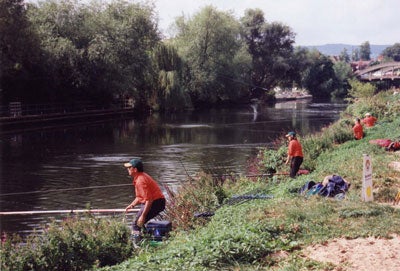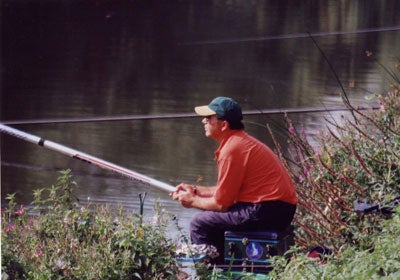| MARK WINTLE |
| Mark Wintle, an angler for thirty-five years, is on a quest to discover and bring to you the magic of fishing. Previously heavily involved with match fishing he now fishes for the sheer fun of it. With an open and enquiring mind, each week Mark will bring to you articles on fishing different rivers, different methods and what makes rivers, and occasionally stillwaters, tick. Add to this a mixed bag of articles on catching big fish, tackle design, angling politics and a few surprises. Are you stuck in a rut fishing the same swim every week? Do you dare to try something different and see a whole new world of angling open up? Yes? Then read Mark Wintle’s regular column. |
| THE DECLINE OF MATCHFISHING Has the golden age of matchfishing passed? Will open matchfishing disappear? Will the National championships go the same way? And will club matchfishing eventually go the same way? I believe that match attendances are declining, and have been for a number of years. It’s hard to define exactly when matchfishing peaked; possibly in the seventies, though there were much bigger matches held in the decades before that time. What makes it more complex is that the emphasis of matchfishing has altered over the decades, and continues to alter.
The way that we use our limited leisure time, and the choices available have changed dramatically; the availability of cars, and even the waters themselves, have altered our expectations of what we want from angling from that accepted thirty, forty, or even fifty years ago. Matchfishing grew from a demand to escape the weekly drudgery of being cooped up in factories (and mines) all week. With cheap rail travel, and later coaches and cars, it was possible to escape en mass to the countryside for a day before returning to the factory floor on Monday. Much of the fishing was not that good, and most could not afford decent tackle, so catches were for the most part poor. To liven things up a sweepstake would be held so that at least there was something apart from the crates of beer to create a bit of interest. Some of the matches from thirty to fifty years ago were on a scale barely imaginable today. The Birmingham Anglers Association Annual Big ‘un peaked at 8000 anglers, and for many years had 4-5000 anglers with the venue encompassing the Severn, Warwickshire Avon and various canals (an entry of around 200 now). The big breweries sponsored gala matches for the legions of Sheffield anglers on the Witham and Welland, and these often had over a thousand anglers competing. Many of these matches were gigantic club matches (CIU membership) rather than open matches though big river championships that were open to all developed alongside the galas. Certainly by the early seventies anglers like Ivan Marks never had it so good with big matches available on a regular basis on the Welland, Nene, and Witham during the summer. In autumn the emphasis switched to the Trent where 300 peg opens became the norm. At this time Kevin Ashurst remarked that open wins for matches under 300 competitors didn’t really count.
The make-up of the National Championships underwent a change at the same time (1972). Smaller clubs were allowed to join the NFA in their own right, whereas before most competing clubs had been the big associations. With the all-England match at capacity (the last single National had around 115 teams of 12 in 1971) it was decided to split the match into two divisions. Two became three, then four, five and eventually six. By the time it got to six divisions, many of the teams were match groups with less than twenty members. Conversely, some of the big associations began to question the expense of entering the National; with their best anglers lured away by ‘super’ teams, entries declined. Some of the smaller teams also began to find the expense too much. Lured by the glamour of the big match they had joined the NFA in droves but found the reality altogether different. By the time the cost of NFA membership, a week’s practice, overnight accommodation, bait and pools were added up, an individual bill of £ 500 was typical, and for what? Their only reward was a hard day’s fishing on a strange venue for a pound or two, and little chance of promotion to the top flight. If the trend for ever more nationals had reversed into decline then so had the demand for more and bigger opens. When Angler’s Mail set up its Matchman of the Year competition in the seventies, it initially set the minimum qualifying match size to a hundred pegs. It quickly found out that many matches in the West Midlands failed to make that number and dropped the entry to 80 pegs. Incredibly, anglers like Billy Makin, Dave Thomas and John Dean had little trouble dominating the competition by regularly winning matches that were often in excess of three hundred pegs. In time, this limit was dropped again to sixty pegs, and finally to fifty pegs. Extraordinarily, Angling Times continues to report ‘Opens’ that are as small as a dozen pegs, hardly open to all England! The Winter League has also peaked. At one time, only a decade ago, there were over forty leagues in operation. These had a minimum of ten teams of twelve, and some were much bigger. So, you had matches of at least 120 anglers. But the same decline set in that affected the open circuit, and the size of teams was decreased to ten, but this hasn’t proved enough to reverse the decline and some leagues have folded, and others look set to go the same way. So, what factors have caused this decline? Firstly, in the past you had little choice but to fish a match if you wanted to fish at all on a Sunday near somewhere like Nottingham. Many river venues like the Trent, Witham and Severn would be booked solid with club and open matches. It was a case of join in or have nowhere to go. Reliance on organised transport was another factor.
But as numerous stillwaters were developed from the seventies onwards, and the majority of anglers got their own transport, the necessity to compete in a match disappeared. Why fish a predetermined peg, at predetermined times, when you can simply fish where and when you wish? Let’s face it, matchfishing is a time consuming pastime. To get five hours fishing you require up to two hours beforehand to meet and draw, and get to your pegs. This time seems to have increased over the years. Add in the time for the packing up and weigh-in, and results, and the overall time at the venue is up to around eight hours. Furthermore, matchfishing is hard work. It’s alright in good conditions but as you don’t get to choose your peg, there are often times when you’ve got to battle a facing wind, or otherwise awkward conditions. Many years ago I read that if ever there was a true level playing field in matchfishing then attendances would decline alarmingly. In those far off days, the luck of the draw on largely natural venues like rivers meant that the crack anglers often struggled off bad pegs. This coupled with generally much lower weights meant that there was always a chance that a much lesser angler might have a chance. One of the best examples of this that I can find is of huge matches held on the Lancaster Canal in the early seventies. These drew fields of over a thousand yet a weight of two pounds was enough to win. As the winner would have picked up several hundred pounds at a time when wages were but a fraction of that it was a form of bingo. One lucky bream and you were in. But the meteoric rise of commercial carp waters has changed all that. With weights that can exceed a hundred pounds (and sometimes a hell of a lot more), the days of the lucky fish are mostly long gone. Now the cracks really do dominate proceedings and few anglers stick around if they feel that they simply cannot compete on any terms. One of the other factors in this complex problem is that young anglers starting fishing today simply do not take the match route. When I started matchfishing in 1970, a club match of 25 anglers would have up to 10 juniors fishing (and a right bloody nuisance we were, too!). But as we matured, we continued matchfishing so that in the late seventies the average age at our (well supported) club matches was probably in the late twenties. Few competitors were over 50. Matchfishing is generally a young man’s game (I know that Bob Nudd is close to 60), because you need the sharp eyes and reflexes of youth. Go and look at today’s matches. Many of the anglers are those same anglers that were the young ones of twenty-five years ago with the youngsters very much in the minority. So, where are the young anglers? Firstly, I think that there are fewer young anglers joining the sport today, but more importantly, I think that those that do take up the sport are much more likely to take up carp fishing with entirely different expectations of angling. The skills of floatfishing, so essential for matchfishing including pole fishing, are simply passing them by. Is there an answer to this decline? Are there a lot more matches but they are simply unreported? Is there a North/South divide on this decline? Will we end up with plenty of small club matches and opens? Will matchfishing sink into oblivion? Should something be done? Can anything be done? Will there still be nationals in five years time? What do you think? Next: ‘May Day Mullet’ |
















